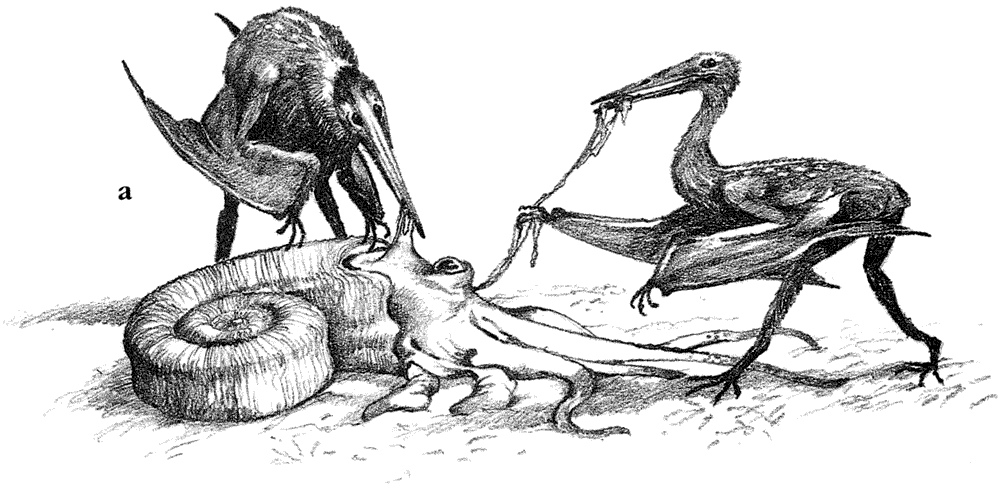| Main | Site library | Forum | Guestbook |
THE AUSTRALASIAN REALM |
|
|
|
|
|
|
|
|
|
|
|
|
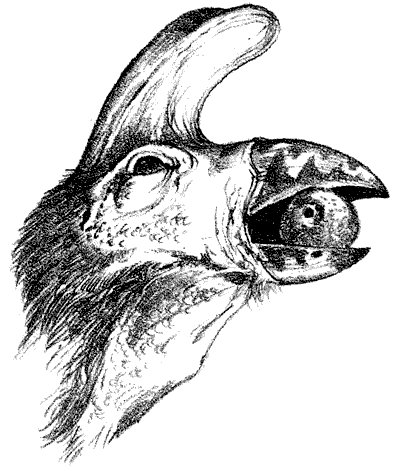
|
High in the luxuriant branches of the tropical forest trees in the
north-east of the Australasian continent, a black and white creature
throws itself
from one branch to another and disappears among the foliage.
At first glance it looks like an arbrosaur, one of the tree-living
coelurosaurs
that are found all over the world. Then it appears again, and
its bright face, surmounted by a high crest, is its most obvious feature.
This is
a crackbeak – a tree-living descendant of the successful hypsilophodonts. |

|
|
Not all tree-living animals are active jumpers. Up in the topmost
branches of the eucalyptus trees of the south-eastern and south-western
corners
of the Australasian continent lives a silvery blob, about 70
centimetres (2 ft) long. This is the tubb, a clumsy-looking creature
moving
sluggishly up and down the silvery grey branches of the eucaliptus
trees, feeding
on nothing but the bluish foliage. At first glance it is difficult
to imagine that both the tubb and the crackbeak are evolved from
the same
hypsilophodont ancestors, yet there are clues. The hind feet
have four toes, the first of which point backwards and allow the animal
to grasp
branches. The hands have five fingers, the outer two of which
are
opposable. The deep head has powerful jaw muscles and a sharp
beak, for breaking
off food from the trees. |
|
|
|
|
|
|
|
|
|
||||
|
|
||||
CONTENTS
FOREWORD
THE GREAT EXTINCTION 6
WHAT IS A DINOSAUR? 10
THE NEW TREE OF LIFE 12
PALAEOGEOGRAPHY 16
ZOOGEOGRAPHY 18
THE HABITATS 20
THE NEW DINOSAURS 29
THE ETHIOPIAN REALM 30
THE PALAEARCTIC REALM 42
THE NEARCTIC REALM 54
THE NEOTROPICAL REALM 66
THE ORIENTAL REALM 78
THE AUSTRALASIAN REALM 88
THE OCEANS 100
CONCLUSION 108
AFTERWORD 109
GLOSSARY 113
FURTHER READING 115
INDEX 116
ACKNOWLEDGEMENTS 120
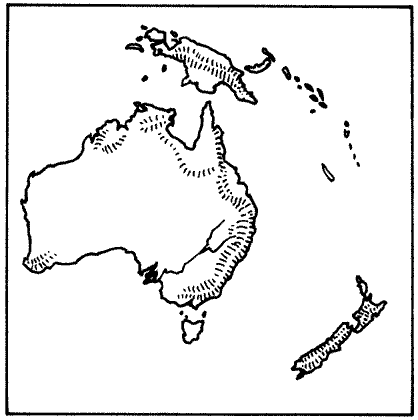 Of
all the palaeogeographic realms the Australasian must be the most
isolated and self-contained. The vast proportion of its bulk
is a single island continent measuring about 3,500 kilometres (2,100
m)
by 3,000
kilometres (1,800 m), straddling the southern tropic. Other portions
of the realm consist of several large and thousands of smaller
islands scattered to the north and east. Some of the eastern islands
are
even more isolated than the main landmass and could be regarded
as small,
individual zoogeographic realms of their own. The islands to
the north consist of continuous archipelagoes reaching towards the
great
northern
continent and the Oriental realm.
Of
all the palaeogeographic realms the Australasian must be the most
isolated and self-contained. The vast proportion of its bulk
is a single island continent measuring about 3,500 kilometres (2,100
m)
by 3,000
kilometres (1,800 m), straddling the southern tropic. Other portions
of the realm consist of several large and thousands of smaller
islands scattered to the north and east. Some of the eastern islands
are
even more isolated than the main landmass and could be regarded
as small,
individual zoogeographic realms of their own. The islands to
the north consist of continuous archipelagoes reaching towards the
great
northern
continent and the Oriental realm.








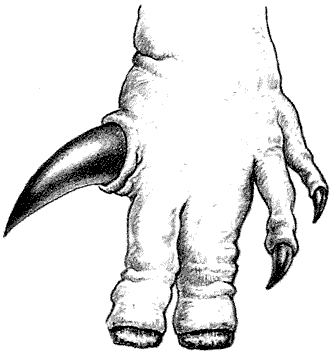



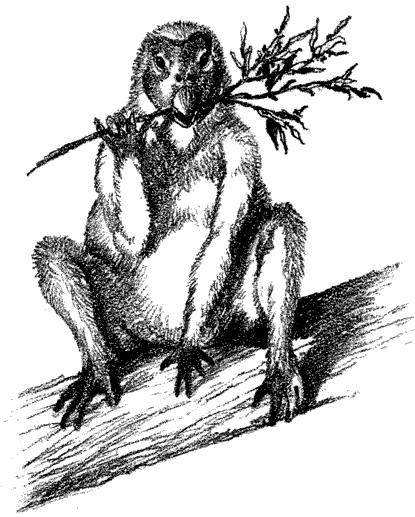
 Herds of wandles roam the grasslands of the southern island in leisurely
moving, unconcerned herds. From an evolutionary point of view they
have reached a final stage. Any influx of animals from other realms
would now be a disaster for them, since they have evolved in total
isolation. They are low in intelligence, are not adapted in any way
for defence against predators, and could not outrun a meat-eater
if they happened to meet one. Nor could they face competition from
the more efficient grass-eaters that exist elsewhere.
Herds of wandles roam the grasslands of the southern island in leisurely
moving, unconcerned herds. From an evolutionary point of view they
have reached a final stage. Any influx of animals from other realms
would now be a disaster for them, since they have evolved in total
isolation. They are low in intelligence, are not adapted in any way
for defence against predators, and could not outrun a meat-eater
if they happened to meet one. Nor could they face competition from
the more efficient grass-eaters that exist elsewhere.

 The
coiled shell of the coconut grab is flat on the
bottom, providing a skid-like surface that allows it to be dragged
over the sand. There are eight tentacles. The four at the rear are
broad and very muscular. They are used for pulling the animal over
the ground and up coconut palms, left. The front four tentacles are
long and delicate, allowing the ammonite to reach for a coconut.
The eyes can focus both submerged and out of the water. Coconut grabs
usually come ashore at night when it is cooler, and dawn finds the
beach criss-crossed by their distinctive trails, right.
The
coiled shell of the coconut grab is flat on the
bottom, providing a skid-like surface that allows it to be dragged
over the sand. There are eight tentacles. The four at the rear are
broad and very muscular. They are used for pulling the animal over
the ground and up coconut palms, left. The front four tentacles are
long and delicate, allowing the ammonite to reach for a coconut.
The eyes can focus both submerged and out of the water. Coconut grabs
usually come ashore at night when it is cooler, and dawn finds the
beach criss-crossed by their distinctive trails, right.


